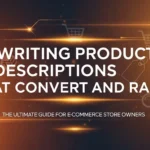Introduction
Link building for ecommerce website growth is no longer a luxury—it’s a must. In 2025, as Google’s site reputation abuse policy tightens the rules, it’s become harder than ever to earn high-authority backlinks. Ecommerce brands face a unique challenge: how to build quality links without triggering red flags from search engines—or alienating their audience.
Still, link building for ecommerce website SEO remains one of the strongest strategies for driving consistent, long-term traffic. Backlinks help Google understand your site’s authority and relevance, which means the more credible websites link to yours, the better your chances of ranking for high-value keywords.
But ecommerce link building isn’t the same as it used to be. You can’t just drop links in directories or spam comment sections and expect results. Today, link building for ecommerce website optimization is about relevance, relationships, and content quality. You need outreach campaigns that offer real value, plus optimized landing pages that convert traffic once it arrives.
In this guide, we’re diving into everything you need to know about link building for ecommerce website success—including the best tactics, outreach strategies, and content formats that generate links at scale. Whether you’re launching a new store or scaling to 7-figures, the techniques shared here will help you stay ahead of competitors and Google’s algorithm.
Table of Contents
Understanding Link Building for Ecommerce
What is Ecommerce Link Building and Why It Matters
Link building for ecommerce website performance is all about acquiring backlinks—external links that point to your online store from other websites. These links act like votes of trust, telling Google your site is credible, useful, and deserves higher rankings in search results.
Unlike traditional websites, ecommerce platforms have a commercial intent that can make link acquisition more complicated. You’re not just linking to content—you’re often trying to build links to product pages, category pages, or sales landing pages. That’s a big ask for publishers who want value-rich, non-promotional content.
So why does it still matter?
Because backlinks remain one of Google’s top three ranking factors. Data from Ahrefs shows a strong correlation between the number of referring domains and higher keyword rankings. Ecommerce sites with robust backlink profiles get:
- More organic traffic
- Higher conversion potential
- Better visibility across long-tail and short-tail keywords
In short, without a solid backlink profile, you’ll struggle to compete in search—no matter how good your products are.
SEO Benefits of Backlinks for Ecommerce Sites
When done right, link building for ecommerce websites offers more than just better rankings. It improves your overall domain authority, boosts referral traffic, and creates brand visibility that leads to higher trust and credibility.
Let’s break down the direct SEO benefits:
| Benefit | Impact |
|---|---|
| Higher Keyword Rankings | Backlinks help search engines trust your pages more, improving rank. |
| More Referral Traffic | Users from third-party sites click through and become customers. |
| Improved Indexing | Backlinks help Google crawl and index your site faster. |
| Increased Domain Authority | Strong backlinks raise your entire domain’s credibility. |
Effective link building for ecommerce website SEO also feeds into your internal linking strategy, creating stronger site architecture and more optimized crawl paths for search engines.
Types of Ecommerce Backlinks That Actually Work
Editorial Links, Guest Posts & Resource Page Mentions
Not all backlinks carry equal weight especially when it comes to link building for ecommerce website success. In fact, the source of your backlink can determine how much authority gets passed to your page and how Google perceives its relevance. That’s why building editorial backlinks from niche-relevant and high-authority sites should be at the core of your ecommerce link strategy.
Here are the top editorial link types that work in 2025:
- Guest Posts: Writing in-depth blog articles for industry blogs is still effective. Just ensure the content is non-promotional, valuable, and contextually includes a link to a relevant ecommerce page (like a product category or blog guide).
- Resource Page Links: These are curated pages listing useful tools, products, or articles. Pitch your content or product page as a resource worth including. It works especially well for unique tools or high-quality buying guides.
- Brand Mentions in Articles: Earned media is powerful. Getting featured in listicles, industry roundups, or expert commentary pieces helps drive traffic and authority.
Pro Tip: Use SEO tools like Ahrefs Content Explorer or BuzzSumo to find articles in your niche that already link to similar products or guides. Reach out and suggest yours as a more updated or niche-specific option.
Influencer Features, Brand Mentions & Product Roundups
In modern ecommerce SEO, link building has expanded beyond traditional blogs. Today, link building for ecommerce websites also happens through influencers, niche creators, and product curation platforms.
Here’s how these work:
- Influencer Product Reviews: Partnering with bloggers or niche influencers who write detailed reviews gives you high-quality, natural backlinks. Always aim for sites with a domain authority (DA) above 40 and traffic aligned with your niche.
- Product Roundups: These list-style posts feature “Top 10,” “Best of,” or “2025 Picks” in specific categories. Get your product featured here by pitching unique selling points or offering expert commentary.
- Brand Mentions in Expert Content: Featuring subject matter experts (SMEs) on your site or offering expert quotes to publishers can earn reciprocal links. Many publications will quote and credit your site if your insight is valuable.
Example: A skincare brand linking to their hyaluronic acid serum from a dermatologist-reviewed product roundup can gain not only traffic but credibility, especially when the content is educational and balanced.

Targeting the Right Pages for Backlink Campaigns
Choosing Between Product Pages, Category Pages & Blog Posts
One of the biggest mistakes brands make in link building for ecommerce website campaigns is targeting the wrong pages. Unlike B2B or service websites that typically build links to a few landing pages or blog articles, ecommerce sites often have thousands of URLs. But not all pages are created equal or worth linking to.
Here’s a simple breakdown to help you choose where to focus your backlink strategy:
| Page Type | Link Worthiness | Use Case |
|---|---|---|
| Category Pages | ⭐⭐⭐⭐ | Ideal for mid-funnel keywords like “best men’s sneakers” |
| Product Pages | ⭐⭐ | Works for unique, trending, or high-converting products |
| Blog Posts & Buying Guides | ⭐⭐⭐⭐⭐ | Best for building editorial and natural links |
- Category Pages are often overlooked, but they’re perfect for link building for ecommerce website SEO. They target high-volume, high-converting keywords and can naturally fit in listicles, resource pages, or curated shopping guides.
- Product Pages are more difficult to earn links for because of their commercial tone. However, if the product solves a problem or is truly unique, you can still earn backlinks through influencer product reviews or niche roundups.
- Blog Posts and Guides are your link building engines. They allow you to target informational intent keywords and serve as the bridge between SEO and content marketing. Most editorial and PR backlinks should point here first.
To maximize ROI, start with blog posts that support your product categories. These assets are easier to promote, especially when they answer common questions, provide value, or include subject matter expert (SME) insights.
Keyword Mapping and Link Relevance
Once you’ve chosen your link targets, the next step in link building for ecommerce website growth is mapping relevant keywords to those pages. Keyword mapping ensures that the links you build don’t just generate traffic—they also support your overall SEO goals.
Here’s how:
- Classify Keyword Intent
- Informational — Great for blog posts
- Commercial — Target category pages
- Transactional — Focus on product pages
- Map Keywords to Link Targets
For example:- “how to choose the right LED TV” → blog post
- “best 65-inch smart TVs” → category page
- “Samsung Neo QLED review” → product page
- Match Anchor Text Naturally
A critical part of link building for ecommerce website optimization is anchor relevance. Use branded, partial match, or contextual anchor texts, like:- “Explore modern office chairs”
- “Read our mattress size comparison”
- “Check out our home gym essentials”
The more aligned your keyword, anchor, and page content are, the stronger the backlink becomes in Google’s eyes.
Essential On-Site Optimization Before Outreach
Fixing Technical SEO, Core Web Vitals & Site Structure
If your store isn’t technically sound, even the best link building for ecommerce website plan will fail. Backlinks can only help your rankings if your site is accessible, fast, and structured properly for search engines to crawl.
Here’s what to fix before you start building links:
- Core Web Vitals & Speed
Google’s ranking system heavily relies on performance. Test your pages using PageSpeed Insights and prioritize improving LCP (loading), FID (interactivity), and CLS (visual stability). A fast site supports your link building for ecommerce website by keeping users engaged once they land on your page. - Mobile Responsiveness
Over half of ecommerce traffic comes from mobile devices. Make sure all linked pages especially category and product URLs—are mobile-optimized. A responsive site improves dwell time and SEO, reinforcing your link building for ecommerce website goals. - Crawl Errors, Redirects & Site Structure
Run audits with tools like Ahrefs or Screaming Frog. Eliminate 404s, reduce redirect chains, and create a clean structure:Home > Category > Subcategory > Product
This ensures that link equity flows properly and enhances crawlability. - Secure and Clean URLs
Make sure all target URLs use HTTPS, are indexable, and free of query strings or tracking parameters. Backlinks pointing to a clean, readable URL offer more trust value to users and search engines.
Internal Linking Strategies to Amplify Backlink Impact
A powerful yet underutilized method in link building for ecommerce website SEO is internal linking. When you earn a backlink to one part of your site like a blog guide or infographic you should internally pass that authority to high-converting pages.
Here’s how:
| Internal Linking Tip | Benefit |
|---|---|
| Use keyword-rich internal anchors | Boosts topical relevance and page authority |
| Link from content to categories or products | Directs link juice where it converts |
| Add links early in the content | Improves crawl depth and engagement |
| Use breadcrumbs for better UX | Helps Google and users navigate effectively |
Let’s say you create a buying guide on “Top Travel Backpacks” and it earns backlinks. Internally link from that guide to your “Travel Bags” category and related product pages. This approach leverages link building for ecommerce website growth while improving site navigation and sales potential.
Internal linking also supports seasonal campaigns. For instance, during Black Friday or Cyber Monday, promote collections internally from high-traffic blog posts or static pages. You increase visibility while maximizing link value.
Every time you earn a new backlink, ask: “How can I push this equity deeper into my ecommerce funnel?”
When you optimize both your technical SEO and internal links, link building for ecommerce website success becomes easier, more efficient, and significantly more profitable.
How to Build Backlinks for Ecommerce Sites in 2025
Guest Blogging, Broken Link Building & Niche Edits
Modern link building for ecommerce website SEO requires strategy, creativity, and a shift away from outdated tactics. The most effective backlink strategies in 2025 center on editorial value and trust, not just link placement.
Let’s explore three proven tactics:
1. Guest Blogging for Authority and Reach
Guest posting still works when done right. Instead of writing for any site that accepts posts, focus on niche-relevant blogs with real traffic and good domain authority (DA 40+). Write content that naturally references your blog guides, product categories, or tools.
Pro Tip: Avoid over-optimizing anchor text. A branded or descriptive phrase is more natural and effective for long-term SEO.
2. Broken Link Building
This involves finding broken links on relevant sites and offering your own content as a replacement. It’s a win-win: the site owner fixes an error, and you get a backlink.
Here’s how:
- Use Chrome extensions like Check My Links or SEO Minion
- Find broken links on resource pages or blogs in your niche
- Pitch your blog post or category page as a replacement
This strategy works well in link building for ecommerce website campaigns, especially when your content fills a genuine informational gap.
3. Niche Edits (Link Insertions)
These are backlinks added to existing content on other websites—often easier to acquire than full guest posts. Reach out to site owners and suggest placing a link to your product or guide within a relevant article.
Example: You sell air purifiers. Find a blog post titled “Top Allergy Solutions for Spring” and pitch your category page or blog article on indoor air quality.
Skyscraper Content, FAQ Pages & SME Quotes
4. Skyscraper Outreach
The Skyscraper technique involves creating content that’s more detailed, current, or engaging than what’s already ranking. Find top-performing content, build something better, and promote it to the same sites linking to the original.
Use Ahrefs or Semrush to:
- Identify blog posts with high backlink counts
- Create a more comprehensive guide
- Reach out to linking domains with your improved version
When done correctly, this content-driven approach supports sustainable link building for ecommerce website SEO.
5. Answering FAQs on Product or Blog Pages
Incorporate high-volume, long-tail keyword questions directly into your pages. Not only does this help with voice search and user experience it also earns backlinks.
Example: A mattress store answering “How long does memory foam last?” might get links from review blogs, forums, and journalists looking for expert insights.
6. Featuring Subject Matter Experts (SMEs)
SMEs add credibility to your content and give it a “linkable” edge. Interview dermatologists, mechanics, chefs depending on your niche and include their insights. They often link back to the piece themselves and may be cited by others.
How to Build 100 Backlinks in 30 Days or Less
Daily Outreach Plan: Templates, Tools & Execution
Achieving 100 backlinks in a month may sound ambitious, but with the right link building for ecommerce website strategy, it’s absolutely achievable. The secret? Treat link acquisition like a system—not a shot in the dark.
Whether you’re a new online store or a 7-figure brand, you’ll need consistent outreach, the right tools, and highly valuable assets worth linking to.
Here’s a battle-tested 4-week campaign structure:
| Week | Focus | Daily Goals |
|---|---|---|
| Week 1 | Prospecting | Collect 40–60 qualified domains/day |
| Week 2 | Outreach | Send 50–100 personalized emails/day |
| Week 3 | Follow-ups | Reconnect with 100% of non-responders |
| Week 4 | Monitor & Publish | Track secured links, anchors, DR, and pages |
This systematized approach makes link building for ecommerce website SEO predictable and scalable.
Step-by-Step Execution Plan
1. Prospect the Right Sites
Use tools like Ahrefs, BuzzSumo, and SEO Minion to find:
- Niche blogs
- Buying guide publishers
- Roundup curators
- Influencer-led review sites
Sort domains by traffic, relevance, and domain rating. Always ask: “Would I link to this site if I were a customer?” If the answer is no, skip it.
Start your link building for ecommerce website campaign by compiling 1,000+ prospects to contact during the month.
2. Personalize Outreach at Scale
Avoid generic templates. Use dynamic personalization tokens like:
- First name
- Post titles they’ve published
- Shared interests in niche topics
Example cold pitch:
“Hey Anna, loved your post on minimalist home design! I just published a guide to eco-friendly desk decor for modern spaces. Could it fit in an upcoming roundup?”
This approach builds real rapport and wins more backlinks.

3. Follow-Up Like a Pro
70% of backlinks during link building for ecommerce website campaigns come from follow-ups. Don’t be afraid to nudge editors. Use a second email that:
- Reframes the value (e.g., “Here’s a stat or quote your readers may like”)
- Offers a second link target (like a supporting blog or tool)
- Keeps it friendly and brief
4. Track Everything
Use Google Sheets, Airtable, or a CRM like Pitchbox to log:
- Outreach status (sent, opened, replied)
- Link status (live, pending)
- Anchor types used
- Page type linked to (blog, category, product)
This data makes link building for ecommerce websites not just tactical—but measurable.
AI & CRM Tools to Automate at Scale
To scale efficiently, integrate automation while keeping the human touch.
Best tools for ecommerce link outreach:
- Hunter, Scrapebox: Email discovery
- Mailshake, Instantly: Automated sequences
- Lemlist: Personalization & warm-up
- Notion, Pitchbox: Project management
Add AI into your system:
- Use ChatGPT to draft email intros
- Jasper to A/B test subject lines
- SurferSEO to optimize blog posts for linkability
By combining automation with smart personalization, you create a high-efficiency machine for link building for ecommerce website campaigns.
Assets That Attract Backlinks
No one links to weak content. These are the link-worthy assets that support link building for ecommerce website growth:
| Asset Type | Purpose |
|---|---|
| Buying Guides | Add value to listicles and resource pages |
| Infographics | Shareable content for bloggers & Pinterest |
| Tools/Calculators | Solve real customer problems |
| Expert Interviews | Provide quote-worthy authority |
| Comparison Posts | Rank for BOFU keywords & get affiliate links |
Each of these can be promoted via outreach, press pitches, and even affiliate networks. Your link building for ecommerce website workflow becomes easier when your content speaks for itself.
Link Quality Over Quantity
Sure, we’re targeting 100 backlinks but not at the cost of relevance or authority. A successful link building for ecommerce website campaign prioritizes:
- Sites with DA 40+
- Niche relevance
- Real traffic
- Balanced anchor text
Avoid PBNs, spammy blog networks, or any site selling links openly. These shortcuts kill your SEO and risk penalties.
When your ecommerce site earns links from real publishers with authority in your niche, every backlink acts as a growth multiplier.
Sustaining Your Link Velocity
Building 100 links in 30 days is impressive but it should be repeatable. Here’s how to maintain a healthy backlink velocity month after month:
- Batch new campaigns every 30 days
- Build new linkable assets quarterly
- Revisit old contacts to request additional placements
- Leverage HARO for consistent press mentions
- Explore influencer product seeding with linkbacks
A long-term plan for link building for ecommerce website authority allows your brand to climb and stay competitive even in saturated categories.
Final Thought: A great ecommerce product won’t rank on its own. It needs links. And not just any links real, contextual, trusted backlinks that tell Google you’re worth showing on page one.
Put this 30-day plan in place, repeat it monthly, and watch your ecommerce website’s SEO climb while your competition tries to figure out what changed.
Best URL Structure for Ecommerce Websites
Flat vs. Hierarchical: What’s Best for SEO in 2025?
When it comes to link building for ecommerce website performance, the structure of your URLs matters more than most store owners realize. Your URL not only communicates page relevance to users and search engines but also impacts how link equity flows across your site.
There are two dominant URL structures for ecommerce stores:
| Structure Type | Example URL | Pros | Cons |
|---|---|---|---|
| Flat | /product-name | Simple, short, easy to remember | Lacks category context |
| Hierarchical | /category-name/product-name | Clear navigation path, better SEO context | Can be longer or duplicated |
Which is better for link building?
The hierarchical structure typically wins. It places your products within meaningful categories, which helps Google understand topical relationships and strengthens internal linking. It also improves anchor text relevance when building backlinks.
If you’re pursuing link building for ecommerce website SEO, using clear category and subcategory folders makes it easier to rank product and collection pages individually.
Pro Tip: Keep URLs short, readable, and include the primary keyword. Avoid unnecessary parameters (?ref=123) and stop words (and, with, a) wherever possible.
Example:
✅ /outdoor-furniture/wooden-patio-set
❌ /collections?product_id=456&sort=price
Using Keywords & Avoiding Dynamic Parameters in URLs
Clean URLs increase both click-through rate and indexability. They also make your site easier to pitch during outreach. No editor wants to link to a messy, confusing link.
Here’s what optimized URLs support in link building for ecommerce website campaigns:
- Trustworthy appearance: Editors are more likely to link to static, readable URLs
- Keyword inclusion: Reinforces the anchor text and page topic
- Anchor diversity: Short URLs allow for natural variations in linking language
Example of Good Practice
Let’s say you’re building links to a “men’s waterproof boots” page:
✅ /mens-boots/waterproof — includes keywords, easy to share
❌ /shop-now/item?id=7890 — generic, unattractive to link to
In addition, short, keyword-rich URLs help you rank for long-tail keywords, especially when tied to a strong link building for ecommerce website plan that targets both blog posts and commercial pages.
A great URL structure doesn’t just improve user experience it increases your chances of earning high-quality backlinks. It also improves crawlability, link distribution, and keyword visibility across your ecommerce store.
Combined with on-site SEO and intentional outreach, clean URLs are an essential ingredient in successful link building for ecommerce website optimization.
Measuring Ecommerce Link Building ROI
Tracking Organic Traffic & Keyword Rankings
Every effective link building for ecommerce website strategy must be measurable. If you can’t track the results of your backlink efforts, you won’t know what’s working or where to double down.
Start by defining your SEO success metrics, then match them to measurable KPIs. Here’s what to track:
| Metric | Why It Matters |
|---|---|
| Organic Traffic | Indicates visibility and keyword movement |
| Keyword Rankings | Measures performance for specific target terms |
| Referral Traffic | Shows which backlinks are driving real users |
| Bounce Rate & Dwell Time | Helps assess user intent and content match |
| Domain Rating (DR) & Authority | Reflects SEO strength and trust signals |
To monitor these, use:
- Google Search Console for impressions and rankings
- Google Analytics 4 for traffic and conversions
- Ahrefs / SEMrush for backlinks and DR tracking
Use filters to isolate URLs that gained new links and monitor them weekly. Did rankings improve? Are they gaining clicks? Link building for ecommerce website SEO should create a measurable lift in both traffic and engagement.
Evaluating Link Quality with DR, Traffic & Conversions
Not all backlinks are equal. One powerful link from a DR 80 site can outperform 20 low-quality links. That’s why assessing link quality over quantity is key in ecommerce.
Here are your link quality indicators:
- Domain Rating / Domain Authority
Tools like Ahrefs and Moz assign a score (1–100) to websites based on backlink profile strength. Aim for DR 40+ sites as a baseline for valuable backlinks. - Relevance
Links from sites in your niche whether it’s pet care, fashion, or tech pass stronger topical signals. Relevance boosts the impact of link building for ecommerce website pages like collections and product guides. - Anchor Text Profile
Diversify anchors. Use branded, exact match, partial match, and contextual phrases to avoid over-optimization. - Traffic & Visibility
Use SimilarWeb or Ahrefs to check if the linking domain gets real monthly traffic. A link from a high-traffic page is more likely to drive conversions and engagement. - Follow vs. Nofollow
Aim for a healthy mix. While “dofollow” links pass ranking value, “nofollow” links from trusted sites (like news media or Reddit) still drive referral traffic and trust.
Pro Tip: Add UTM parameters to links in guest posts or influencer content. This lets you track conversions tied to specific link building for ecommerce website campaigns inside Google Analytics.
A data-driven approach transforms your link building for ecommerce website strategy from a cost center into a revenue driver. By measuring what matters, you can justify the investment and scale your link acquisition with confidence.
Common Link Building Mistakes to Avoid
Buying Spammy Links or Overusing Exact Match Anchors
Even with the best intentions, it’s easy to go wrong with link building for ecommerce website campaigns. Many ecommerce brands especially new ones fall into traps that harm more than help their rankings.
Let’s start with the most damaging mistake: buying backlinks from low-quality sites.
Google’s 2024 site reputation abuse policy has made it easier to identify unnatural link patterns. Paying for links on PBNs, forums, or link farms can trigger penalties, de-indexation, or ranking suppression.
If a site openly sells links or lists hundreds of unrelated external domains it’s a red flag. Real backlinks come from editorial discretion, not paid placements on link-stuffed sites.
Another critical issue: overusing exact match anchors.
If you repeat that same anchor text across multiple backlinks, you risk triggering algorithmic filters. A safer, more natural approach for link building for ecommerce website pages is to mix anchor types:
| Anchor Type | Example |
|---|---|
| Branded | “Explore TimberTrek’s footwear collection” |
| Partial Match | “Men’s waterproof styles like these” |
| URL | “https://yourstore.com/mens-boots” |
| Generic | “Click here to browse all options” |
A balanced anchor profile builds trust and reflects real editorial context.
Ignoring Link Diversity & Nofollow Opportunities
Too many ecommerce businesses chase only one type of link from blogs, or only guest posts. But for a robust link building for ecommerce website strategy, you need diversity.
That includes:
- Press mentions
- Resource pages
- Social shares with link previews
- Influencer reviews
- Directory or niche roundups
- UGC forums or community-based links
A natural backlink profile includes “nofollow” links too. While they don’t pass PageRank directly, they still drive referral traffic, build brand visibility, and reduce footprint manipulation.
Also, don’t ignore internal linking. Even if you earn a top-tier backlink to your blog post, its value is limited unless you internally link that blog to a revenue-driving category or product page.
Finally, be wary of quantity over quality. Earning 10 backlinks from trusted, high-authority sources will outperform 100 spammy links in the long run and protect your domain.
Avoiding these missteps is what separates ecommerce sites that scale from those that stagnate. Smart, strategic, and clean link building for ecommerce website SEO is the only way forward in today’s competitive landscape
Conclusion: Building Links That Scale with Your Ecommerce Business
In today’s search landscape, link building for ecommerce website success is no longer optional it’s foundational. With increased algorithm scrutiny and rising competition, building high-quality, relevant backlinks is one of the few SEO strategies that still consistently delivers results.
You’ve learned:
- Why link building still matters more than ever in 2025
- Which types of backlinks generate real traffic and authority
- How to structure URLs and content for maximum linkability
- A proven 30-day plan to build 100+ quality backlinks
- Metrics to measure ROI and mistakes to avoid
Whether you’re promoting a product category, boosting a blog guide, or launching a new online store, a strong link building for ecommerce website strategy puts your brand in front of customers before your competitors.
But remember: link building is a long game. The most successful brands treat it as an ongoing growth engine not a one-time fix. Consistency, value-driven outreach, and clean on-site SEO are what elevate an ecommerce site from buried to visible.
Start small, stay strategic, and scale your backlinks month by month. Your rankings and revenue will follow.
FAQs About Link Building for Ecommerce Website SEO
What is ecommerce link building?
Ecommerce link building is the process of acquiring backlinks to your online store from other websites. These links help boost your site’s authority in search engines like Google, improve keyword rankings, and drive referral traffic. Specifically, link building for ecommerce website SEO often targets category pages, blog content, or buying guides rather than just the homepage.
Backlinks act like votes of confidence, showing Google that your site is trustworthy and relevant especially when those links come from high-authority or niche-relevant sources.
How to build backlinks for ecommerce?
There are multiple ways to build backlinks for ecommerce stores, including:
Guest blogging on industry blogs
Niche edits (adding links to existing articles)
Broken link building by offering replacements for 404s
Skyscraper content (creating superior content that earns links)
Featuring SMEs (Subject Matter Experts) to increase shareability
Building FAQ-rich product pages for long-tail backlink opportunities
Partnering with influencers and other brands
When done right, link building for ecommerce website visibility not only improves rankings but helps you attract buyers at all stages of the funnel.
What is the best URL structure for ecommerce?
The best URL structure for ecommerce is clean, keyword-rich, and hierarchical. Example:
✅ /mens-sneakers/high-top-white
❌ /product?id=1234&ref=store
This type of structure supports link building for ecommerce website growth by improving crawlability, trust, and user experience. It also increases the likelihood that editors and bloggers will want to link to your pages.
How to build 100 backlinks in 30 days or less?
To build 100 backlinks in 30 days, your ecommerce brand needs a scalable, repeatable outreach strategy. Here’s a high-level roadmap:
Prospect: Use Ahrefs, BuzzSumo, or Google to build a list of 1,000+ potential link targets
Pitch: Send personalized outreach emails daily
Follow up: Reconnect with unresponsive prospects
Offer value: Promote guides, tools, quotes, or product comparisons
Track: Log progress, optimize subject lines, and analyze link quality
Using this structure, link building for ecommerce website SEO becomes more than a guessing game it becomes a predictable process.






